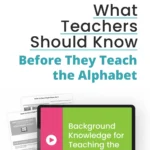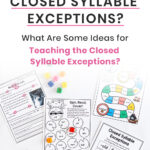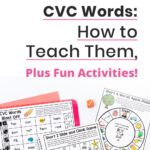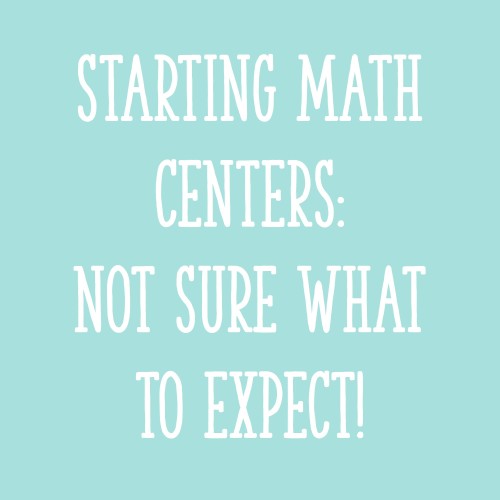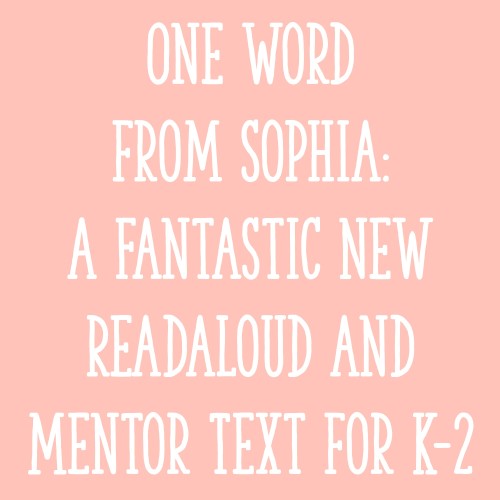Words with short vowel sounds are usually the first words kids learn to read! A lot of the time, these words follow the common pattern of CVC words with three letters, made up of a consonant (C), short vowel (V), and another consonant (C). Even though these words are “simple,” it can take a LOT of practice for a beginning reader to learn to read short vowel words!
Here’s the difference between a short sound and a long sound for vowels:
- In the word “hop,” there is a single vowel “o.” When you sound out the word, it’s /h/ /ŏ/ /p/. The sound that “o” makes here is called a “short o sound.”
- Now let’s look at the word “hope.” In this new word, there is a second vowel “e” added to the first vowel “o.” The “e” does not make any sound at all. (Some call this a “sneaky e” or “magic e.”) With the power of the silent “e,” the sound changes for the “o” vowel. Instead of a short vowel sound, the “o” now makes the long “o” sound. So the word is pronounced /h/ /ō/ /p/.
The English vowels “a,” “e,” “i,” “o,” and “u” all have short sounds. (If you’ve heard the saying, “a, e, i, o, u, and sometimes y” – the letter “y” does not have a “short sound,” but it can represent the short i, long i, or long e vowel sounds, in addition to its consonant sound.)
Short vowel sounds do not just come in the form of CVC words! Here are some other examples of short vowels found in words with digraphs and blends:
- the short “i” sound in the word “chick”
- the short “u” sound in the word “plum”
In this particular blog post, I’ll explain how to teach short vowel sounds! The good news is that there are tons of fun activities for young readers to practice these words.
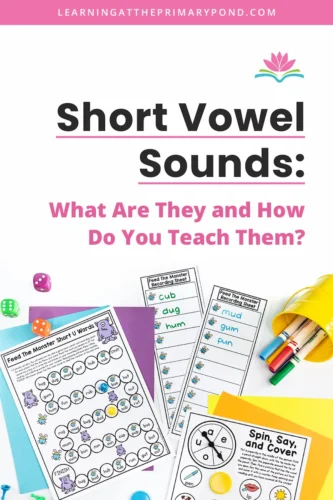
How to Teach Short Vowel Sounds
Build Letter Fluency
The first step in teaching students to read words with short vowels is to teach them the alphabet! To read a CVC word, for instance, a child has to be able to quickly recognize the individual letters in the word. Then they must produce the letter sounds quickly enough so that they can blend (put the individual sounds together) to read the word. For this reason, focusing on letter sound fluency is a great way to get kids ready to read words with short vowels.
As you’re teaching letters, point out the vowel letters and the short vowel sounds they produce. In Kindergarten, I recommend only teaching the short vowel sound when introducing letter name/letter-sound relationships. (For example, with the letter “i,” I would use a short “i” sound in the word “igloo” – “/ĭ/, /ĭ/, igloo” to help students remember the sound for “i.” I would not introduce the long “i” sound and say something like “/ī/, /ī/, ice cream.” They can learn the long sound a little later on.)
In my Reading Intervention product for CVC words, students use a multisensory approach, using simple movements, to learn short vowel sounds. In the example below, students would say “‘o’ says /ŏ/” as they trace the letter “o” with a finger. Then they move on to trace with a pencil, marker, or crayon.
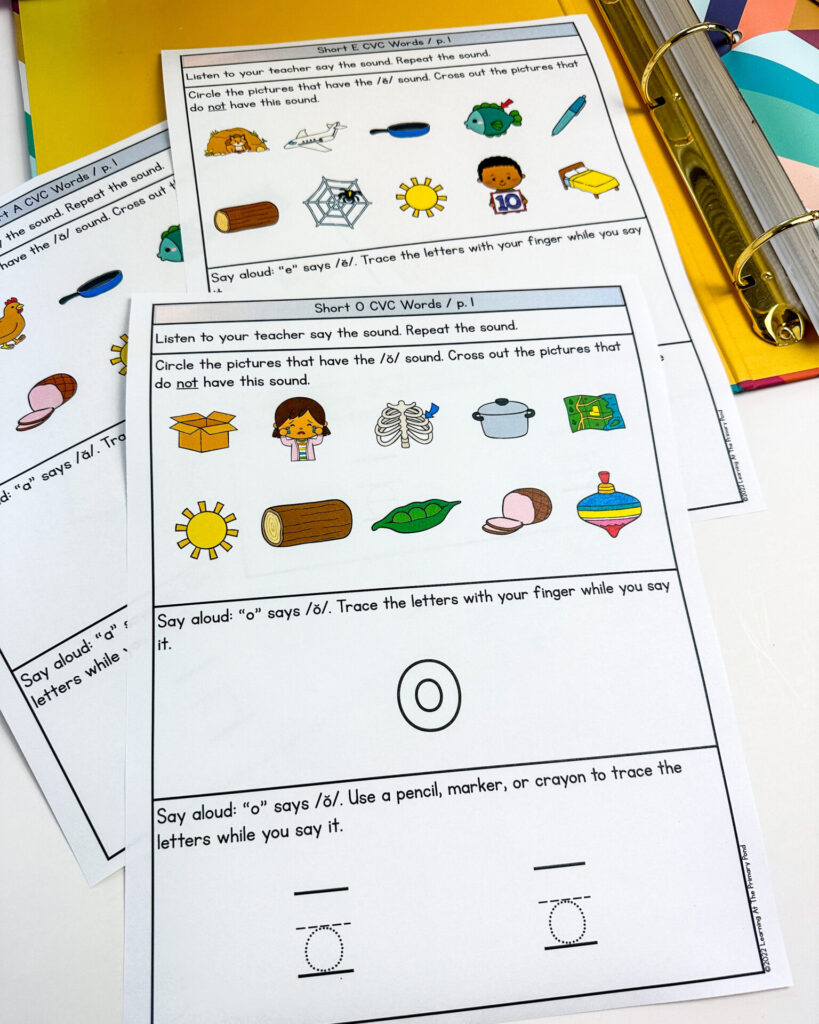
Another thing you really want to have students pay attention to is the mouth formations for each short vowel. When I’m introducing a new sound or reviewing tricky patterns, I exaggerate my mouth shape. It’s really important to make sure students are looking at your mouth as you model the sound. Here’s an example of mouth shape when it comes to short vowel sounds (these sound cards are included in From Sounds to Spelling):
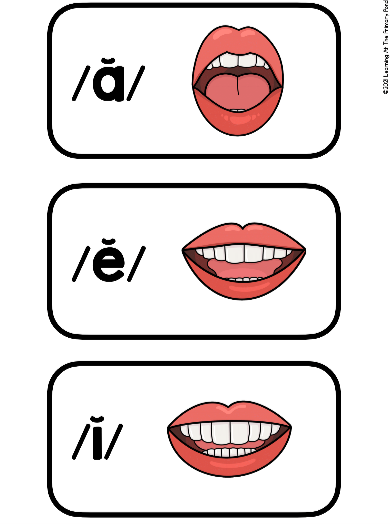
The differences between vowel sounds can be very slight, so it’s important to initially exaggerate how wide or narrow your mouth is. This way, students can both hear and see the difference. Another helpful practice is to give students small mirrors to watch their own mouths move for pronunciation.
Teach Short Vowel Words As You Teach the Alphabet
Many teachers think that kids need to know all of their letters of the alphabet before learning to read short vowel words – but this isn’t correct! It’s actually a great idea to start modeling how to blend to read words with short vowels as you teach the alphabet.
For example, if students have learned the letters a, t, and s, you can show them how to sound out and read the words “at” and “sat.” At this stage, you will model how to say each sound and put the sounds together. The kids can join in once they see how to do it. Here is what it might sound like:
Teacher (sliding finger underneath letter cards): Listen while I say the sounds and blend to read this word: /sss/ /ăăă/, /să/, /t/, sat. Now let’s do it together.
Teacher and Students: /sss/ /ăăă/, /să/, /t/, sat.
Teacher: Good! Now I’ll point to each letter and you do it without me.
Students: /sss/ /ăăă/, /să/, /t/, sat.
Teacher: Great job! What word did you read?
Students: Sat!
Teacher: Right! The cat sat on his mat.
You can do this activity (often called a “blending drill”) with an entire class, in small groups, or even one-on-one. You only need to practice with 1-2 words when you are first getting started.
Practice Short Vowels Without Letters
We’ve been talking about having kids blend sounds together, which is exactly what they need to do to read short vowel words! But you’ll also want to have kids practice identifying short vowels without any letters. This is an important phonemic awareness skill (which falls under the broader category of phonological awareness.)
Here are some examples of activities you could do to practice isolating the short vowel sound:
Matching Short Vowels:
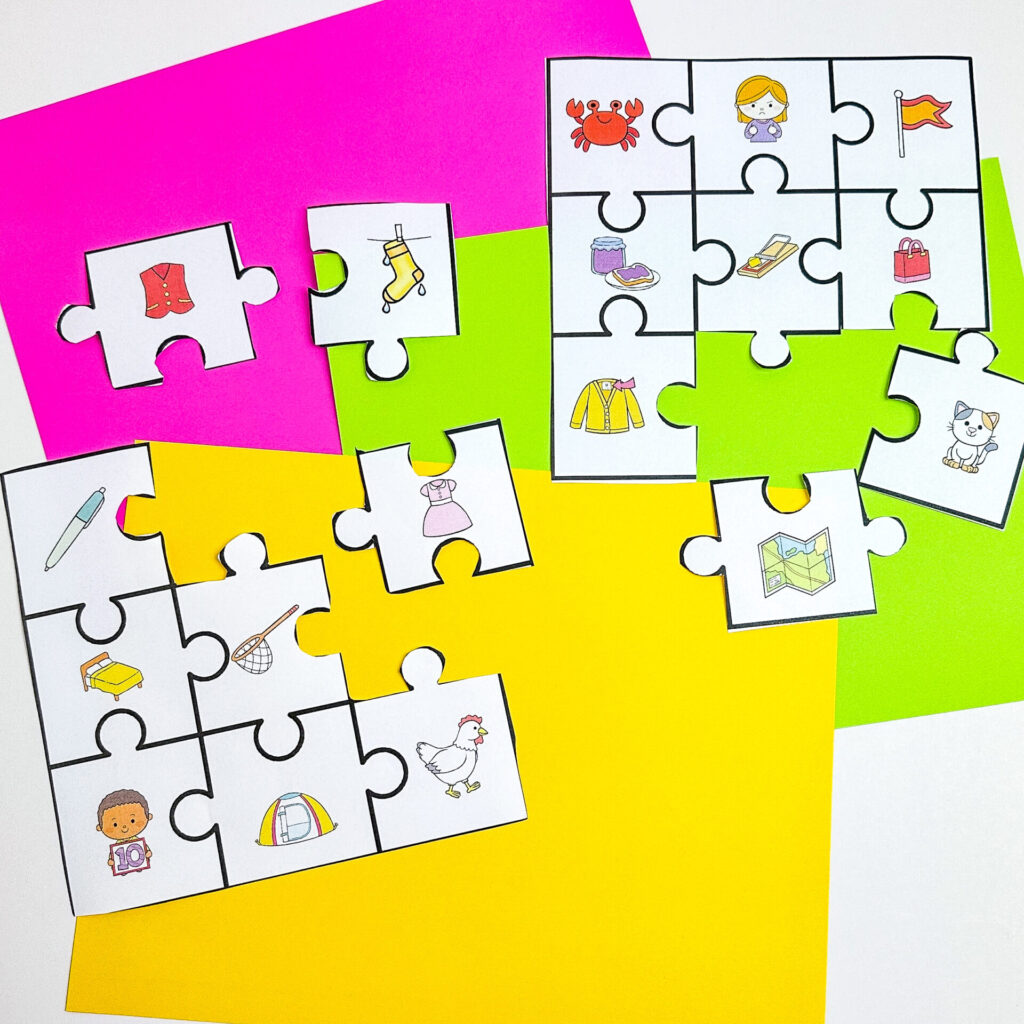
Say and Sort:
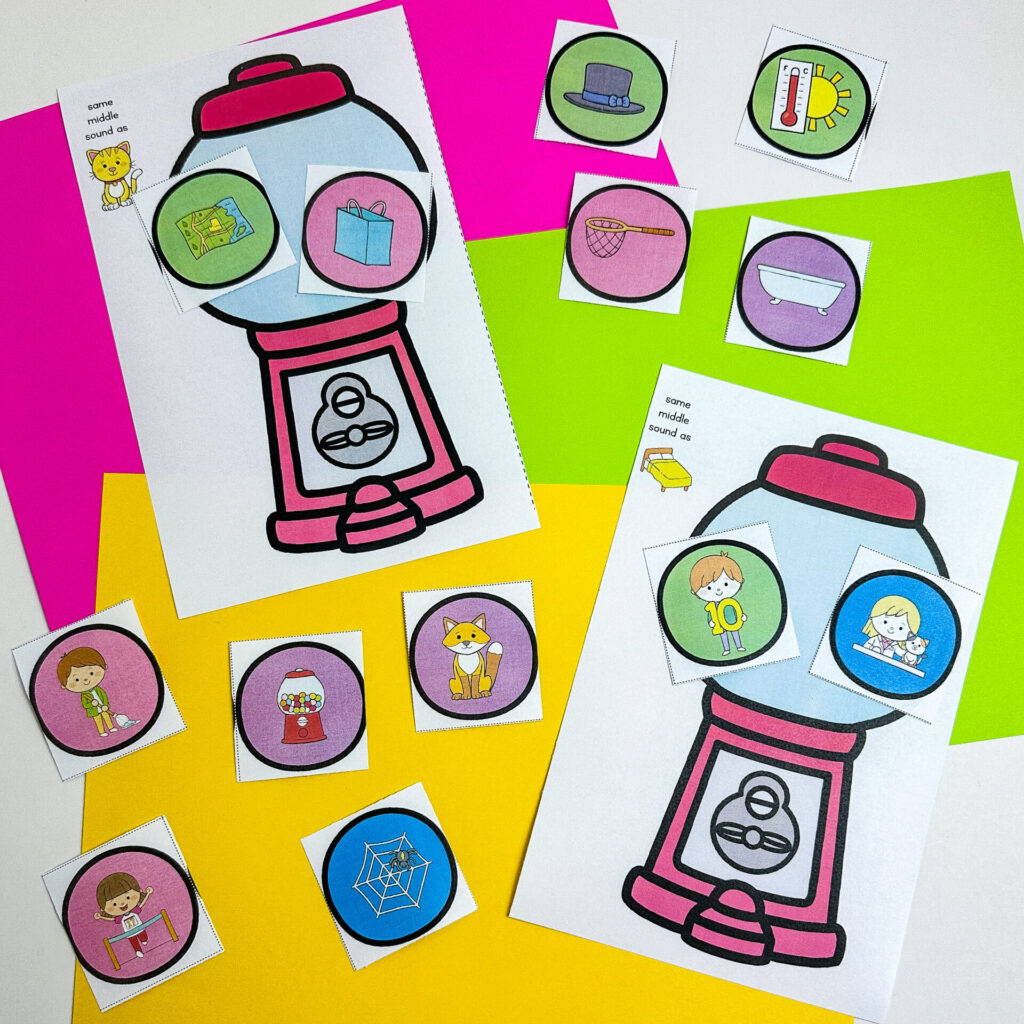
These activities are from my Phonological Awareness Centers for K-2.
Short Vowel Word Lists
Here are some examples of simple, three-letter words with short vowels that you might start with:
Short a words: cab, gab, lab, bad, dad, had, mad, pad, sad, bag, lag, rag, sag, tag, wag, ham, jam, ram, yam, ban, can, fan, man, pan, ran, tan, van, cap, gap, lap, map, nap
Short e words: wed, led, beg, leg, peg, hem, den, hen, men, pen, ten, bet, get, jet, let, met, net, pet, set, wet, yet
Short i words: bib, fib, rib, bid, did, hid, kid, lid, rid, big, dig, fig, gig, jig, pig, rig, wig, dim, him, rim, bin, din, fix, kin, pin, tin, win, dip, hip, lip, rip, sip, tip, zip, bit, fit, hit, kit, lit, pit, sit, fix, mix, six
Short o words: cob, job, mob, rob, sob, cod, nod, pod, rod, bog, dog, fog, hog, jog, log, mom, hop, mop, pop, top, cot, dot, got, hot, jot, lot, not, pot, rot, tot, box, fox
Short u words: cub, hub, rub, sub, tub, bud, dud, mud, bug, dug, hug, jug, lug, mug, pug, rug, tug, gum, hum, mum, sum, bun, fun, nun, pun, run, sun, cup, pup, bus, but, cut, gut, hut, nut, rut, yum
Short Vowel Word Activities
Now let’s get to the really fun part – the activities! There are many fun ways to practice words with short vowels; it doesn’t have to be tedious by any means. These activities are great for small group, literacy centers, or other independent practice. They can even be completed with parents at home, too!
Short Vowel Word Games
Games are so much fun that kids don’t even notice that they’re working hard to practice!
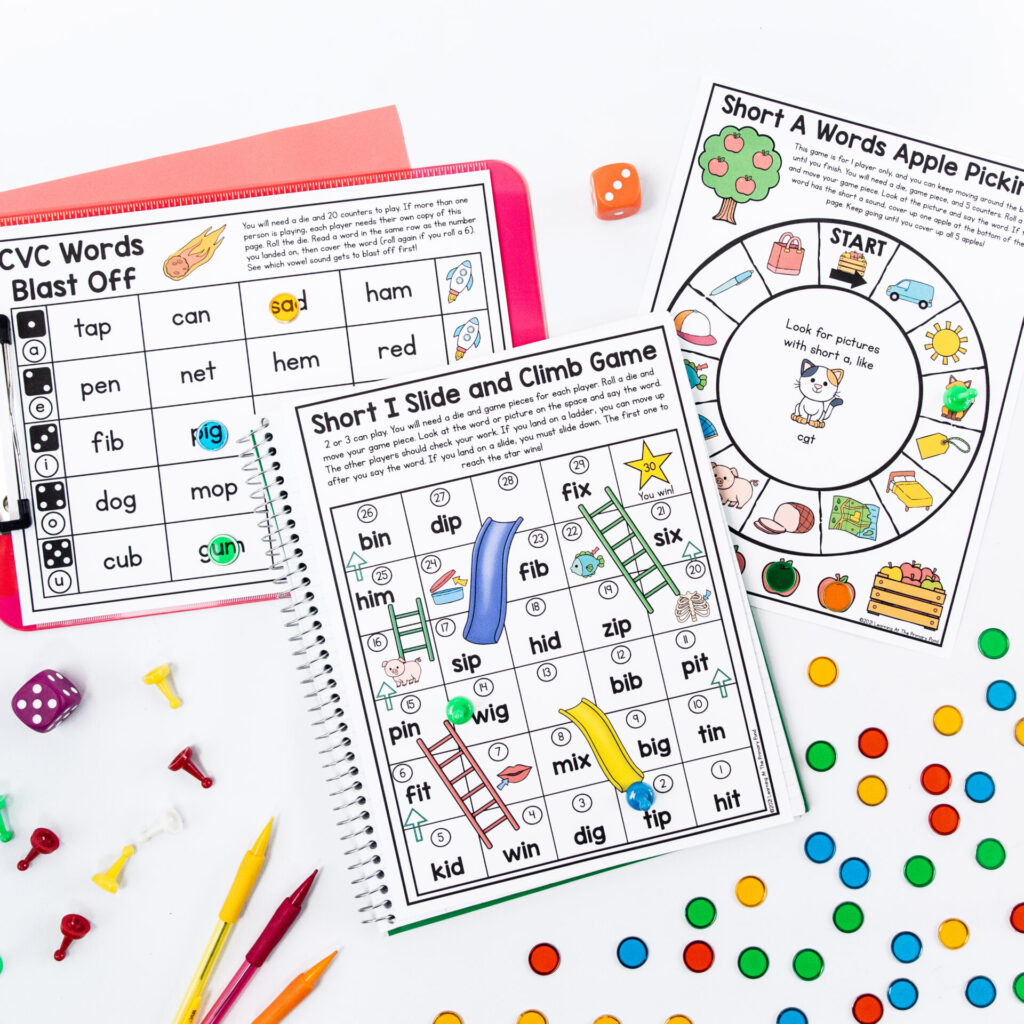
These no-prep phonics games (click HERE for Kindergarten or HERE for 1st grade) have kids practice reading and writing short vowel words. As you can see, there are board games and other variations like “roll and read.”
Short Vowel Word Blending Lines
These short vowel word printables get kids reading individual words and complete sentences with words focused on short vowels. Blending lines have been getting more attention with the recent discussions around the Science of Reading – and for good reason!

If you look “across” a line, you can see that, many times, just one part of the word changes. For example, “lap” becomes “nap.” This helps kids learn to notice small differences in words. When parts of the word stay the same, this builds kids’ fluency and helps them learn to recognize that pattern more quickly in future words.
Take a look at my CVC words blending lines here!
Short Vowel Word Boom Cards
Want to add some digital fun? These Boom cards are a great way for kids to practice, because they’re self-correcting! This means that kids get immediate feedback in the moment, as they’re reading and spelling simple CVC words.
In the photo, you can see that the Boom cards also address short vowel word families to help students see patterns as they learn to read more words with short vowels.
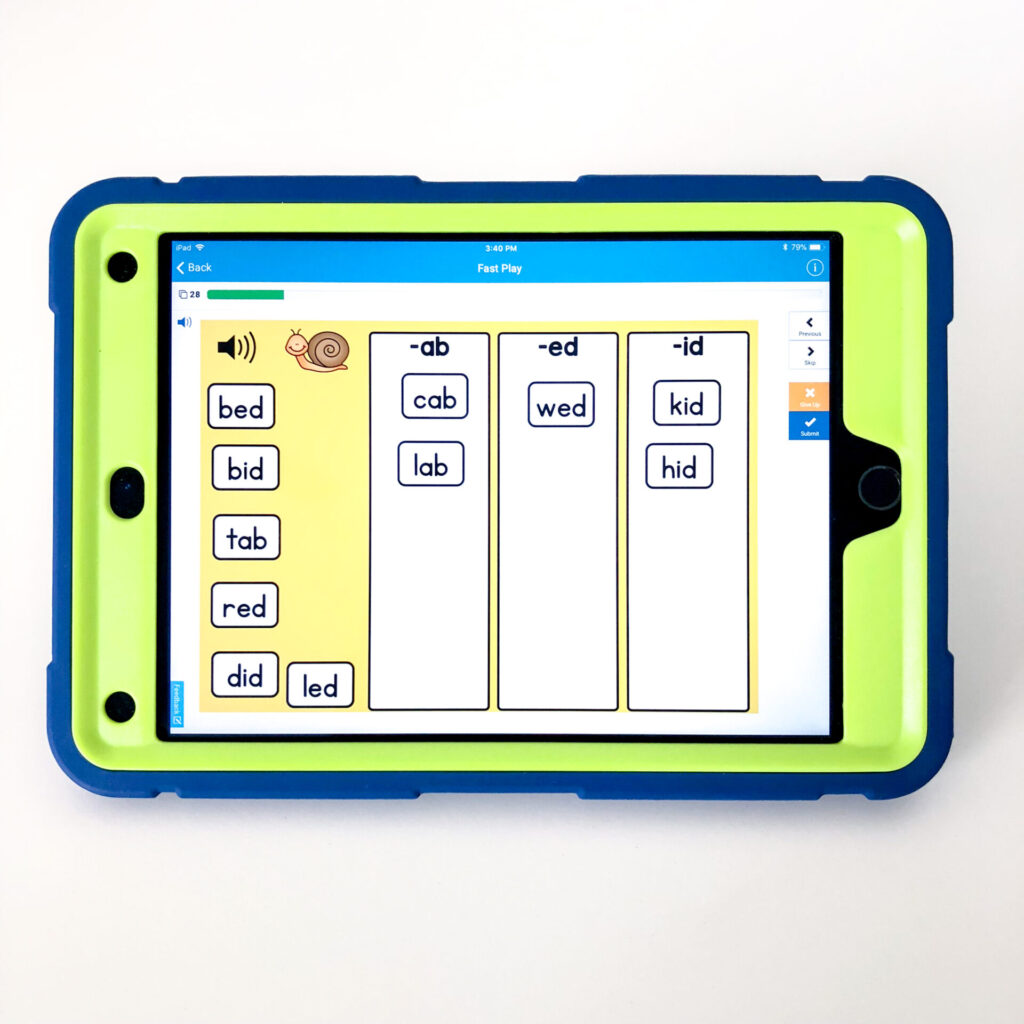
Check out my short vowel phonics Boom cards here!
Short Vowel Word Decodable Texts
Reading individual words is a great place to start, but kids also need to learn to read words in context. These decodable texts are a printable resource that are easy to use – and kids love them! They include simple CVC words AND basic high frequency words.
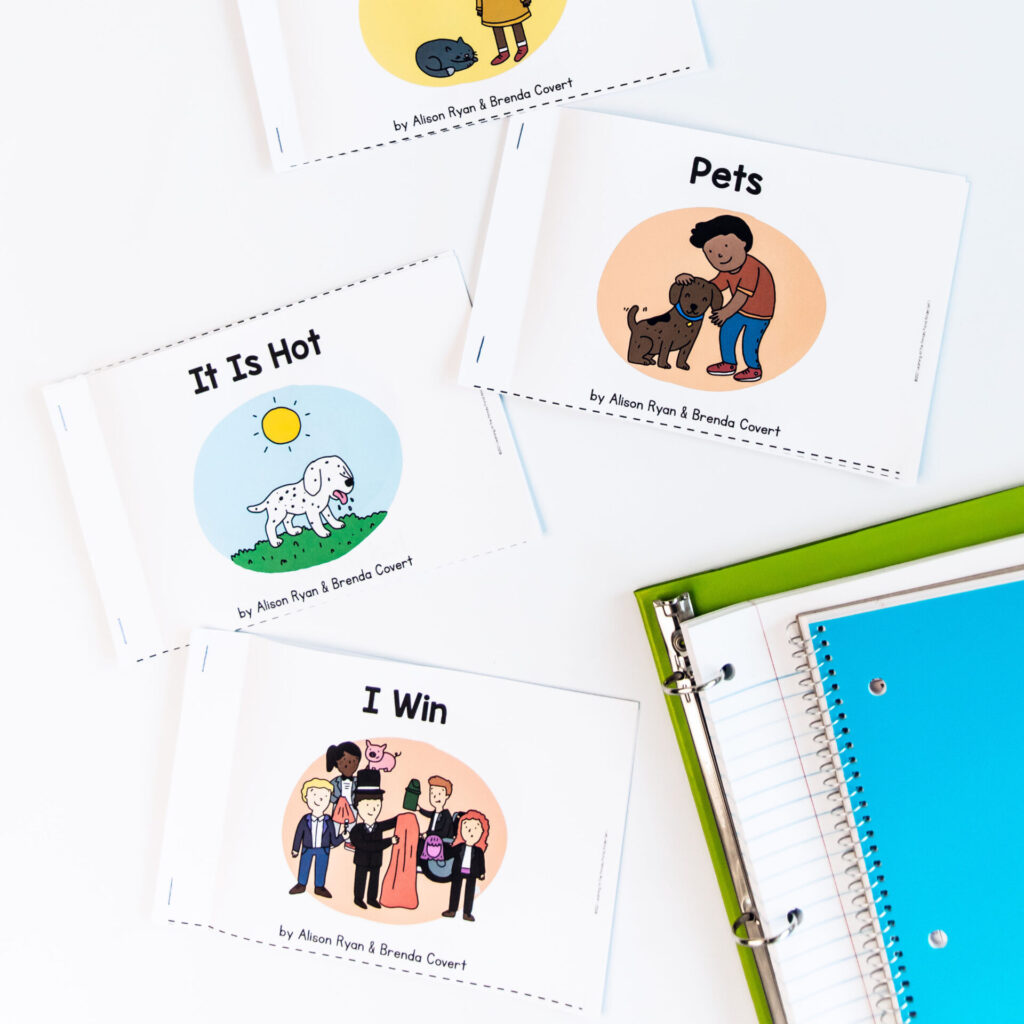
These decodable texts are professionally illustrated and super engaging for kids. You can grab them here!
The Next Step After CVC Short Vowel Words
Wondering what comes after short vowel CVC words? Well, it depends upon what you’ve taught so far. Kids may be ready to work on consonant digraphs or consonant blends – still words with short vowel sounds. Use either of those links to read more about these skills!
Generally speaking, I don’t introduce long vowel sounds until toward the end of Kindergarten or beginning of first grade. However, you can point out a long vowel sound in a student’s own name if they’re writing it every day and wondering why a vowel in their name doesn’t make a short vowel sound. Or if you’re working on a high frequency word like “me,” you could mention “This ‘e’ doesn’t make the short ‘e’ sound. Instead it makes the long ‘e’ sound.” So, you can definitely mention the long sounds as they come up! With a solid foundation in short vowel sounds, young children will have a better understanding of long vowel sounds when the time comes!
Also, just a quick note on multisyllabic words! Short vowel sounds can be found in many multisyllabic words, such as the word “robot.” Without knowledge of short vowel versus long vowel, a student might first think these vowels would make similar sounds. However, with this word, there are different sounds for these same vowels! In the first syllable, the “o” makes a long vowel sound: – /r/ /ō/. In the second syllable, the “o” makes a short vowel sound: /b/ /ŏ/ /t/.
Then there are words that have multiple vowels that are each pronounced as short vowel sounds. Take the word “credit.” Both the “e” and the “i” are short vowel sounds in this word.
The English alphabet and language can be mighty tricky (which can be especially hard for English language learners) because there are also words that have different vowels where one vowel is pronounced with a short vowel sound, and another is pronounced as a long vowel sound. With the word “music,” the “u” makes a long vowel sound, and the “i” makes a short vowel sound.
(For more information on multisyllabic words, you may want to check out this post called “Fun Ideas for Teaching the Syllable Division Rules.”)
Happy teaching!

